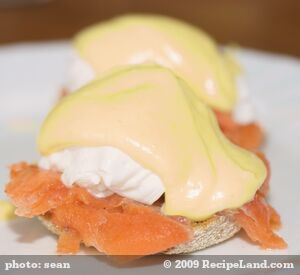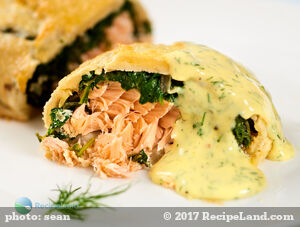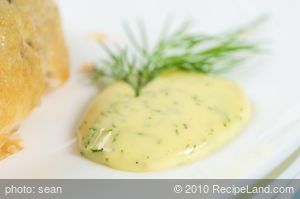Egg yolk and butter sauce flavored with lemon juice. This is THE classic sauce with slight modifications to reduce the amount of fat. It is made with warmed egg yolks flavored with a bit of lemon juice with butter incorporated. It it probably the most famous of all the classic French sauces. Addendum: This recipe is a combination from several French cookbooks including Julia Child & Larousse Gastronomique but uses a bit less butter.
YIELD
6 servingsPREP
5 minCOOK
5 minREADY
10 minThere are number of so-called “classic hollandaise sauce” recipes floating around.
Auguste Escoffier is credited with creating the 5 mother sauces, one of which is hollandaise sauce.
The ingredients of the Escoffier sauce is:
- 8 ounces clarified butter, heated to 125F
- 2 egg yolks
- 5 tablespoons water
- 2 teaspoons vinegar
Salt, black pepper, cayenne and lemon juice to taste.
Ingredients
Directions
How to make Hollandaise Sauce
The egg yolks must be heated slowly and gradually, so they will thicken into a smooth cream. It is not hard but attention is needed, and it is advisable to have all the ingredients ready in advance.
Place the egg yolks in a saucepan and using a whisk beat for about one minute until they become thick and sticky.
Add the water, lemon juice, and salt and beat for another 30 seconds.
Place the saucepan over low heat, or gently simmering water (a double boiler or baine marie). Constantly stir the mixture with the whisk as it slowly heats up. It will take one to two minutes or so to thicken, keep stirring.
If the mixture seems to be thickening too thickly or if there it appears to become a bit lumpy immediately place the saucepan into cold water to cool it and continue stirring. Then continue over low heat.
When the egg yolks have thickened enough you will start to see the bottom of the pot between strokes; you may also notice that the mixture forms a light cream color on the wires of the whip.
Remove from the heat and beat in the one tablespoon of cold butter to cool the egg yolks and stop the cooking.
Beat the egg yolks with the wire whip and begin slowly adding the melted butter a few drops at a time (about ¼ teaspoon at a time) until the sauce thickens into a heavy cream. Then you can add the butter more rapidly beating with the whip the entire time.
Taste and adjust seasonings as desired. Serve warm.
Reduced fat Hollandaise sauce
To make things a bit lower in fat I will only add a few tablespoons of butter instead of the entire ½ cup, and it turns out just great.
Serving suggestions
Hollandaise sauce is served warm and not hot. If you keep it too warm, it will curdle or thin out. It can be held warm for an hour or more in a pan of lukewarm water. The more butter used, the harder it is to hold for an extended period of time. If making an hour in advance use only a bit of butter and beat in softened butter just before serving.
Hints and tips
A teaspoon of cornstarch added at the beginning will help to hold the sauce if kept warm for an extended period of time (hours).
Sauce is too thick?
Beat in one or two tablespoons of hot water, stock or milk.
Sauce refuses to thicken?
This is usually because the butter was incorporated too quickly.
Rinse out a stainless mixing bowl with hot water then add a teaspoon of lemon juice and a tablespoon of sauce. Beat with a wire whip until it creams. Then beat in the remaining sauce a little bit at a time until it has thickened and then add some more. Repeat.
Sauce curdles or separates?
Beat in a tablespoon of cold water to bring it back, if not use the sauce refuses to thicken technique above.
Leftover sauce?
Leftover Hollandaise sauce can be kept refrigerated for a day or two or can even be frozen! You can use it to enrich other sauces, just beat it in a tablespoon at a time. To use it as Hollandaise again, beat two tablespoons of the leftover sauce over very low heat or simmering water in a double boiler then gradually beat in the rest of the sauce a tablespoonful at a time.
Hints, tips, and directions derived from a combination of sources including Larousse Gastronomique, and Julia Childs', Simone Beck’s and Louisette Bertholle’s Mastering the Art of French cooking.






This worked for me perfectly, I followed the directions exactly and to my amazement it turned out perfectly. I had tried once before without much success so had avoided making Holandaise for quite some but this worked flawlessly.
While this is an excellent recipe, this is the one from Julia Child's Mastering the art of french cooking - as I used this recipe last night with barely a word changed. No problem with that but Julia should have been given the credit
I happen to have Mastering the Art of French Cooking by Julia Child, Louisette Bertholle and Simone Beck so I looked up the hollandaise recipe. This doesn't appear to be exactly the same recipe, Julia Child's recipe uses more butter than this.
Also I believe many of Julia Child's recipes are actually from the Cordon Bleu cooking school in France. So I guess credit should really go to them, although I checked Larousse Gastronomique and this recipe looks to be a slightly modified version.
Why would you call it classic when you immediately went and changed it? For ad revenue. Respect lost.
Sorry this is not the original Escoffier recipe. His was prepared with a sec that produces a distinctly different flavor. Although your recipe makes a pleasant lemon sauce.